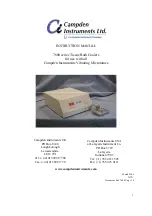
RTC
®
5 PC Interface Board
Rev. 1.9 e
7 Basic Functions for Scan Head and Laser Control
104
innovators for industry
Variable Polygon Delay
A variable polygon delay mode can be activated via
the command
. In this mode, the RTC
®
5
allows varying the length of the polygon delay,
depending on the angle
between the two
successive marking vectors – see
.
For each corner of the polyline, the RTC
®
5 calculates
the variable polygon delay
v_delay
(
) as follows:
v_delay
(
) =
scale
(
)
·
polygon_delay
,
where
scale
(
) is a scaling function (0
scale
(
)
2).
The parameter
polygon_delay
is set by the command
.
(bottom) shows the default scaling
function.
This standard curve can be replaced by a customized
curve. See
"Customizing the Variable Polygon Delay"
.
Edgelevel
shows that the variable polygon delay
becomes quite long if the angle
is close to 180°.
This might lead to burn-in effects in the sharp corners
of the polyline. To avoid this, the user can define a
so-called
edgelevel
: If the polygon delay between
two mark or arc commands is longer than or equal to
this value, the RTC
®
5 turns the laser off after the first
mark or arc command upon reaching the
edgelevel
(after inserting a LaserOff delay) and starts a new
polyline at the beginning of the next mark or arc
command. Also see
. Before
the laser is switched on, the polygon delay will also
(if required) be extended until the LaserOff delay has
completely finished.
For further details see
Edgelevel
Average delay, defined
by
Maximum
34
Variable Polygon Delay
Top: Definition of the angle
Bottom: Variation of the polygon delay (default curve)
f
2
f
1
ff
180°
90°
0°
0
scale
(
f
)
1
2
1 – cos (
f
)
Angle
between the
vectors of a
polygon
















































